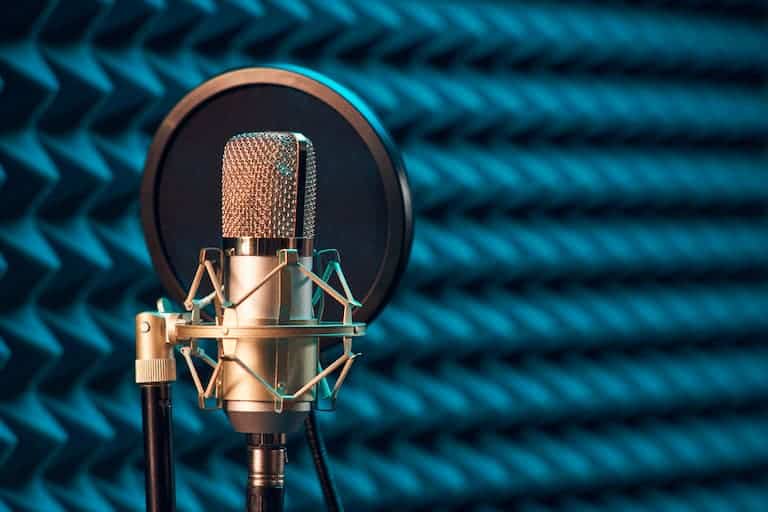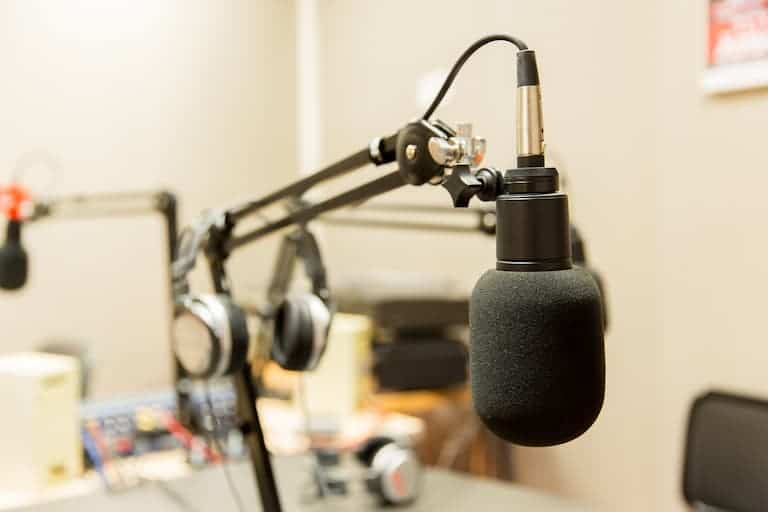When it comes to streaming, there are a few pieces of equipment essential for capturing high-quality audio. Arguably, pop filters and windscreens are two of the most important. But which of the two is better for streaming?
If you stream outdoors often, a windscreen is better than a pop filter. It protects your microphone from wind and other environmental noise. On the other hand, if you’re mostly recording in a controlled environment, a pop filter will do a better job of reducing popping sounds caused by plosives.
If you’ve been struggling to decide whether to buy a pop filter or windscreen for your mic, read on. Here’s a comprehensive guide that’ll help you make the best decision for your needs.

What Is a Pop Filter?
A pop filter is a device that reduces popping noises from vocals and other acoustic instruments by absorbing the sound waves before they reach the microphone. It comprises a metal, plastic, or fabric screen placed in front of the microphone and is held with a clamp or stand.
Most notably, a pop filter helps reduce the occurrence of “plosives“—those pesky B, T, and P sounds that can cause a lot of distortion and pop in your audio.
By absorbing the force of these explosive pops, this device helps create a smoother, cleaner vocal track. And while they may not be glamorous, they’re an essential tool for any home studio.
How a Pop Filter Works
A pop filter works by absorbing or deflecting the sound waves caused by plosives. Plosives are created when you stop the airflow coming out of your mouth with your lips, teeth, or tongue. For example, the consonants P, B, and T are plosives. They become a problem when they hit the microphone and cause a popping noise.
Plosives can sound unpleasant on recordings. Using a pop filter can significantly reduce this problem, enhancing audio quality.

Here’s a YouTube demo of a pop filter in action:
Pros of a Pop Filter
Now that you know what a pop filter is and how it works, let’s take a look at some benefits of using one:
- Reduces distortion and popping. As I mentioned earlier, one of the main benefits of using a pop filter is that it reduces distortion and popping. This makes for a cleaner and more polished streaming or recording.
- Creates a smoother vocal track. A pop filter smoothens your vocal track, getting rid of harsh spikes. This is because it absorbs the sound waves before they reach the microphone, preventing them from causing clipping and distortion.
- Reduces sibilance. Another benefit of using a pop filter is that it prevents high-pitched hissing sounds, or sibilant sounds, from taking over your recording. Examples of this include many s and z sounds. Sibilant sounds can cause harsh and unpleasant sounds in recordings.
- Improves sound quality: In general, using a pop filter will improve the sound quality of your recordings. It reduces distortion and popping, creating a smoother vocal track.
- Larger than a windscreen. Pop filters are also typically larger than windscreens. As a result, they provide a larger surface area to absorb unpleasant sound waves.
Cons of a Pop Filter
There are a few potential drawbacks to using a pop filter:
- May require a separate stand. In some cases, you may need to purchase a separate stand for your pop filter. However, you can avoid this by buying a microphone with a built-in pop filter.
- Can be expensive. Pop filters can be a bit pricey, so they may not be the best option for you if you’re on a tight budget.
- Need proper positioning to work effectively. A pop filter needs to be appropriately positioned in front of the microphone. If it’s not placed correctly, it may not work as well as you’d like.
- Can obstruct the streamer’s view. Since pop filters are typically larger than windscreens, they can block your view. This can be a nuisance if you’re trying to watch the chat while streaming.
What Is a Windscreen?
A windscreen is a device that helps reduce wind noise when recording or streaming outdoors. It’s typically made of foam and fits over the microphone to help reduce the sound of the wind.
A windscreen is typically placed over the microphone, but it can also be placed around it if too much wind noise
comes from all directions.
While windscreens aren’t as commonly used as pop filters, they can be a helpful tool if you’re recording in a windy environment.

How a Windscreen Works
A windscreen works by absorbing or deflecting part of the sound waves caused by the wind. This, in turn, reduces the amount of noise and makes for a cleaner-sounding recording.
While a pop filter is designed to help reduce plosives and sibilance, while a windscreen is designed to help reduce wind noise. This also includes the noise created by the movement of objects in the wind.
Still, a premium quality windscreen can also help reduce plosives and sibilance.
Pros of a Windscreen
Now that you know what a windscreen is and how it works, let’s take a look at some benefits of using one:
- Reduces wind noise. The main benefit of using a windscreen is reducing wind noise. This makes for a cleaner audio recording, especially when recording outdoors.
- Prevents unwanted sounds. Windscreens can also help prevent unwanted sounds from being picked up by the microphone. This is especially helpful when streaming in a noisy environment.
- Improves sound quality. In general, using a windscreen will improve the sound quality of your recordings.
Cons of a Windscreen
There are a few potential drawbacks to using a windscreen:
- Smaller than pop filters. Windscreens are typically smaller than pop filters. As a result, they provide a smaller surface area to absorb sound waves.
- May not filter out plosives as well as pop filters do: While premium quality windscreens can help reduce plosives, some may not be effective at filtering out all pops.
Pop Filter vs Windscreen: Which Should You Choose?
You should choose a pop filter if you stream indoors in a controlled environment. On the other hand, if you often stream outdoors, you should choose a windscreen to protect your microphone from wind noise.
Windscreens are designed for outdoor use. They help control wind noise and protect your microphone from bad weather conditions. If you stream outdoors often or live in an area with many windy days, a windscreen should be at the top of your list.
If you need a windscreen, I recommend this Mudder Microphone Windscreen (available on Amazon.com). It’s made of high-density foam and can fit most standard microphones. Plus, it’s affordable and easy to use.
- Microphone cover set: 5 pieces foam mic cover, 2.9 x 2.5 inches, caliber size is 1.4 inches,...
- Thick and soft foam: the ball-type foam microphone windscreen is soft and thick, has good elasticity...
- Widely application: the foam ball windscreen for microphone is suitable for ktv, dance ball,...
Last update on 2025-05-31 / Affiliate links / Images from Amazon Product Advertising API
If you need a pop filter, I recommend this Aokeo Professional Pop Filter (available on Amazon.com). It’s an excellent option for streamers, thanks to its double-layered mesh design that ensures superior sound quality. Besides, it fits most microphones and is easy to install.
- Double Layered Screen Pop Filters: The first screen blocks air blasts as any pop filter normally...
- Universally Compatible: Adjustable screw rotating clamp with scratch-proof gripper can secure...
- Adjustable Gooseneck: The steel metal gooseneck holder fully supports the filter's weight and keep...
Last update on 2025-05-31 / Affiliate links / Images from Amazon Product Advertising API
If you’re unsure which one to choose, it’s always good to test out both options and see which works better for you and your setup.
And no matter which option you choose, make sure to position the pop filter or windscreen correctly. Pop filters should be placed about 1-2 inches (2.54-5.08 cm) away from the microphone, while windscreens should be as close to the microphone as possible.
Besides using windscreen and pop filters, ensure you use quality software to record or stream audio. For example, Pro Tools is an excellent software for recording audio. If you live stream, you can use software like OBS
to help improve your audio quality.
The Bottom Line
A pop filter is a device that helps reduce plosives and sibilance when streaming or recording. A windscreen is a device that helps reduce wind noise when streaming or recording outdoors.
Both devices can help reduce noise and improve sound quality. Ultimately, the decision of which one to use should be guided by your environment and needs. If you often stream outdoors or in windy conditions, a windscreen may be better. Otherwise, a pop filter should suffice.
Sources
Recent Posts
QuickTime is a vital app for many Mac users, and if you’ve recently bought a new microphone, you might wonder how to use it optimally. QuickTime cannot record audio content if it doesn’t have...
Every microphone leaves a unique signature on the quality of its output. If you’re a podcaster trying to melt your way into your audience’s hearts, a muddy, distorted recording won’t cut it....


